
Vehicle Maintenance and Diagnostics

Augmented Reality (AR) is revolutionizing vehicle maintenance and diagnostics, enhancing both the accuracy of vehicle inspections and the efficiency of maintenance tasks. It offers detailed insights that are assisting both drivers and mechanics.
AR for Vehicle Inspection
AR technology enables thorough vehicle inspections by overlaying digital information directly onto the physical world. By using AR glasses or smartphone apps, inspectors can see data, such as service history, component conditions, and alerts, superimposed on the vehicle parts.
This approach ensures that no issue is overlooked. High-resolution, real-time visuals help in identifying wear and tear, fluid levels, and electronic malfunctions. This enables quicker and more accurate diagnostics compared to traditional methods.
Smart Maintenance Assistance
Smart maintenance assistance with AR provides step-by-step guidance for vehicle repairs and routine maintenance tasks. Mechanics can view interactive 3D models and animations that illustrate how to perform specific procedures, such as engine repairs or brake replacements.
This reduces the likelihood of errors and speeds up the repair process. Additionally, AR can display real-time sensor data, allowing for immediate feedback on the vehicle’s conditions, which helps in making informed decisions about necessary repairs and maintenance.
User Interface and Interaction

Advancements in user interface and interaction play a pivotal role in enhancing the driving experience through Augmented Reality (AR). Specific improvements, such as voice and gesture controls and haptic feedback mechanisms, are transforming the way drivers and vehicles communicate.
Voice and Gesture Controls
Voice and gesture controls provide a hands-free option for interacting with vehicle systems. These systems enable drivers to keep their hands on the wheel and eyes on the road while performing tasks like adjusting the navigation or controlling music.
Voice commands can include setting destinations, making phone calls, or adjusting climate controls. Gesture recognition, on the other hand, allows for simple hand movements to control infotainment systems or answer calls. These technologies aim to minimize distractions, enhancing both safety and convenience.
Haptic Feedback Mechanisms
Haptic feedback mechanisms add a tactile dimension to the AR driving experience. By using vibrations or motions, these systems can alert drivers to various conditions or necessary actions. For example, a vibrating steering wheel can warn the driver of lane departure.
Another application includes feedback through the seat or pedals to indicate proximity to obstacles or other vehicles. This tactile feedback supplements visual and auditory alerts, providing a more comprehensive sensory experience to enhance driving safety and decision-making.
AR in Autonomous Vehicles
Augmented Reality (AR) plays a crucial role in enhancing the driving experience within autonomous vehicles. It primarily focuses on improving passenger information systems and building trust in autonomous systems.
Passenger Information Systems
AR improves how passengers receive real-time information during their journey. Interactive displays can show detailed maps, points of interest, and navigation updates. Passengers can use AR-enabled windows to see augmented views of landmarks, integrating entertainment with information.
In addition, AR can provide safety updates, emergency alerts, and weather conditions, ensuring passengers are always informed. Smart dashboards equipped with AR features can personalize experiences by recommending destinations or showing virtual tours. The seamless blend of virtual imagery with the physical environment creates an engaging and informative travel experience.



